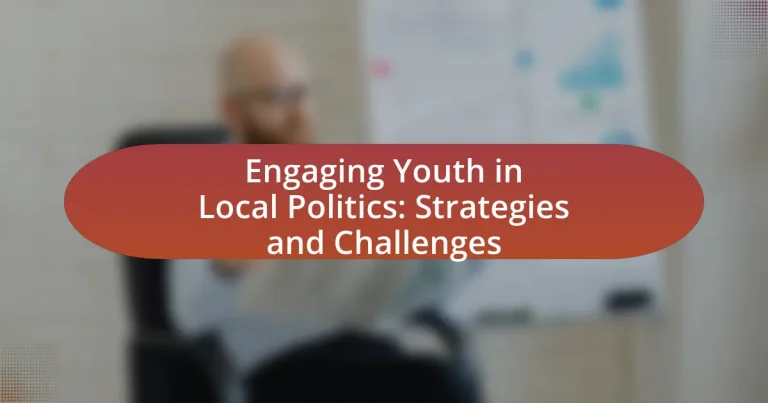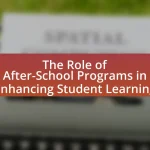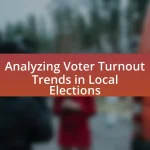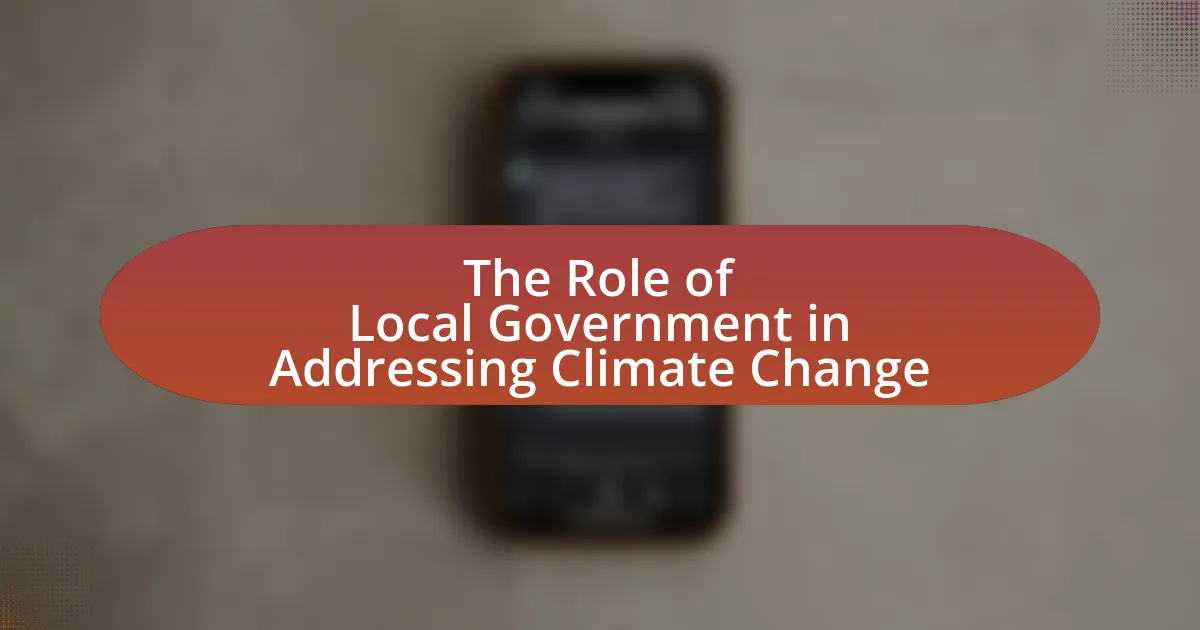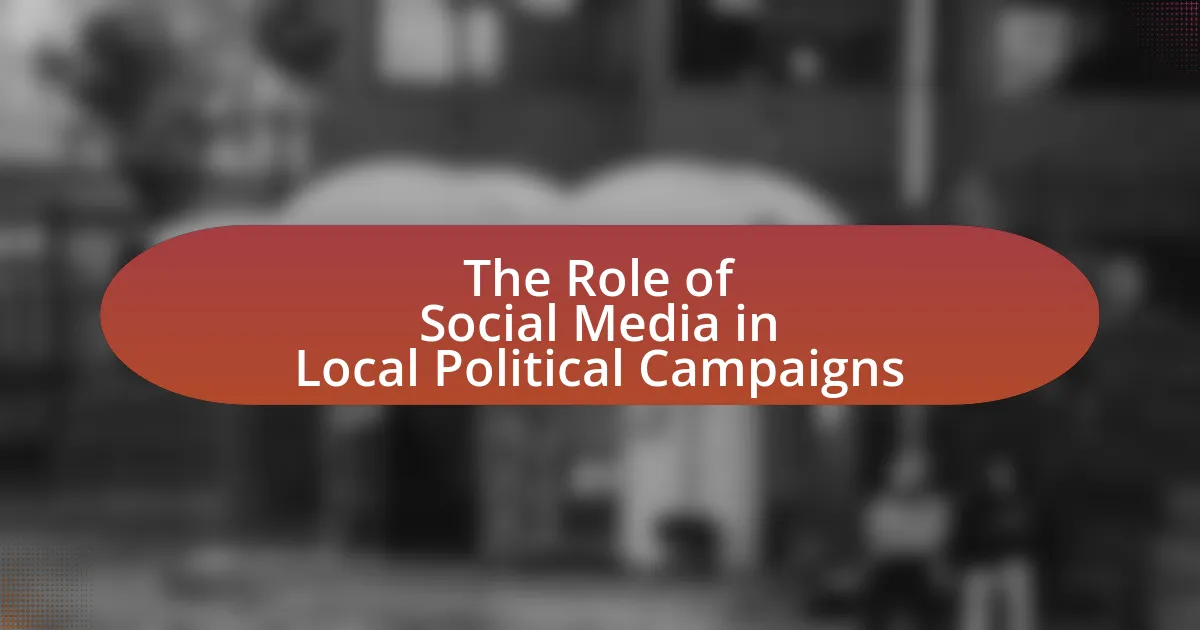Engaging youth in local politics involves actively involving young individuals in decision-making processes, advocacy, and community initiatives that influence local governance. This article explores the importance of youth engagement, highlighting its impact on local governance, policy decisions, and civic responsibility. It discusses current trends in youth political engagement, the role of social media and educational institutions, and effective strategies for local governments to reach young people. Additionally, the article addresses challenges and misconceptions surrounding youth involvement in politics, offering best practices and mentorship programs to enhance engagement.
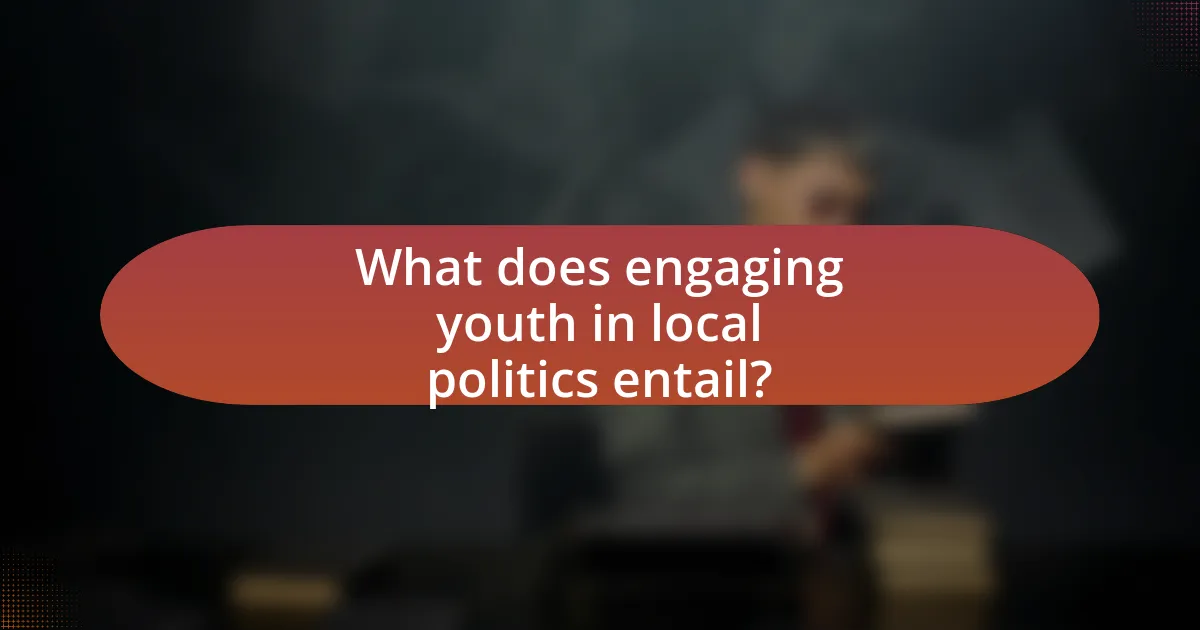
What does engaging youth in local politics entail?
Engaging youth in local politics entails actively involving young individuals in decision-making processes, advocacy, and community initiatives that influence local governance. This engagement can take various forms, including participation in local councils, youth advisory boards, and civic education programs. Research indicates that when youth are engaged, they contribute fresh perspectives and innovative solutions to community issues, enhancing democratic processes. For instance, a study by the National League of Cities found that cities with active youth engagement programs reported higher levels of civic participation among young people, demonstrating the positive impact of such involvement on local governance.
Why is youth engagement in local politics important?
Youth engagement in local politics is important because it fosters civic responsibility and ensures that the perspectives of younger generations are represented in decision-making processes. Engaging youth allows for the incorporation of innovative ideas and solutions that address contemporary issues, such as climate change and social justice. According to a study by the Center for Information & Research on Civic Learning and Engagement, youth who participate in local politics are more likely to remain engaged in civic activities throughout their lives, leading to a more active and informed citizenry. This engagement not only empowers youth but also strengthens democratic processes by promoting diverse viewpoints and encouraging accountability among elected officials.
What impact does youth participation have on local governance?
Youth participation significantly enhances local governance by fostering inclusivity and promoting innovative solutions to community issues. Engaging young people in decision-making processes leads to diverse perspectives that can address the unique needs of the youth demographic, ultimately resulting in policies that are more representative of the entire community. Research indicates that municipalities with active youth engagement initiatives report higher levels of civic responsibility and community involvement among young citizens, which strengthens democratic processes. For instance, a study by the International Youth Foundation found that youth-led initiatives in local governance can increase voter turnout and civic engagement by up to 30%, demonstrating the tangible benefits of their involvement.
How does youth engagement influence policy decisions?
Youth engagement significantly influences policy decisions by ensuring that the perspectives and needs of younger populations are considered in the policymaking process. When young people actively participate in civic activities, such as public consultations or advocacy campaigns, they can shape the agenda and priorities of local governments. For instance, research from the National League of Cities indicates that cities with youth advisory councils report higher levels of youth participation in local governance, leading to policies that better reflect the interests of younger citizens. This engagement not only empowers youth but also fosters more inclusive and representative decision-making, ultimately resulting in policies that address issues like education, employment, and climate change, which are critical to younger demographics.
What are the current trends in youth political engagement?
Current trends in youth political engagement include increased participation through digital platforms, heightened activism on social issues, and a growing emphasis on climate change. Research indicates that 50% of young people aged 18-29 participated in the 2020 U.S. presidential election, a significant increase from previous years, driven largely by social media campaigns and online mobilization efforts. Additionally, youth-led movements, such as the March for Our Lives and climate strikes initiated by figures like Greta Thunberg, demonstrate a shift towards grassroots activism focused on urgent global issues. These trends reflect a more informed and connected generation that prioritizes advocacy and direct action in the political sphere.
How are social media and technology shaping youth involvement?
Social media and technology are significantly shaping youth involvement by providing platforms for engagement, activism, and information dissemination. These digital tools enable young people to connect with peers, organize events, and mobilize for causes, thus enhancing their participation in local politics. For instance, a study by the Pew Research Center found that 69% of teens use social media to express their opinions on social and political issues, demonstrating the role of these platforms in fostering civic engagement among youth. Additionally, technology facilitates access to information, allowing young individuals to stay informed about local political matters and participate in discussions, which further empowers their involvement in civic activities.
What role do educational institutions play in fostering political awareness?
Educational institutions play a crucial role in fostering political awareness by providing students with the knowledge and skills necessary to understand political systems and engage in civic activities. Through curricula that include political science, history, and social studies, schools and universities equip students with a foundational understanding of governance, civic rights, and responsibilities. For instance, research from the Center for Information and Research on Civic Learning and Engagement (CIRCLE) indicates that students who participate in school-based civic education programs are more likely to vote and engage in community service. Additionally, educational institutions often facilitate discussions, debates, and extracurricular activities that encourage critical thinking about political issues, further enhancing students’ political consciousness and participation in local politics.
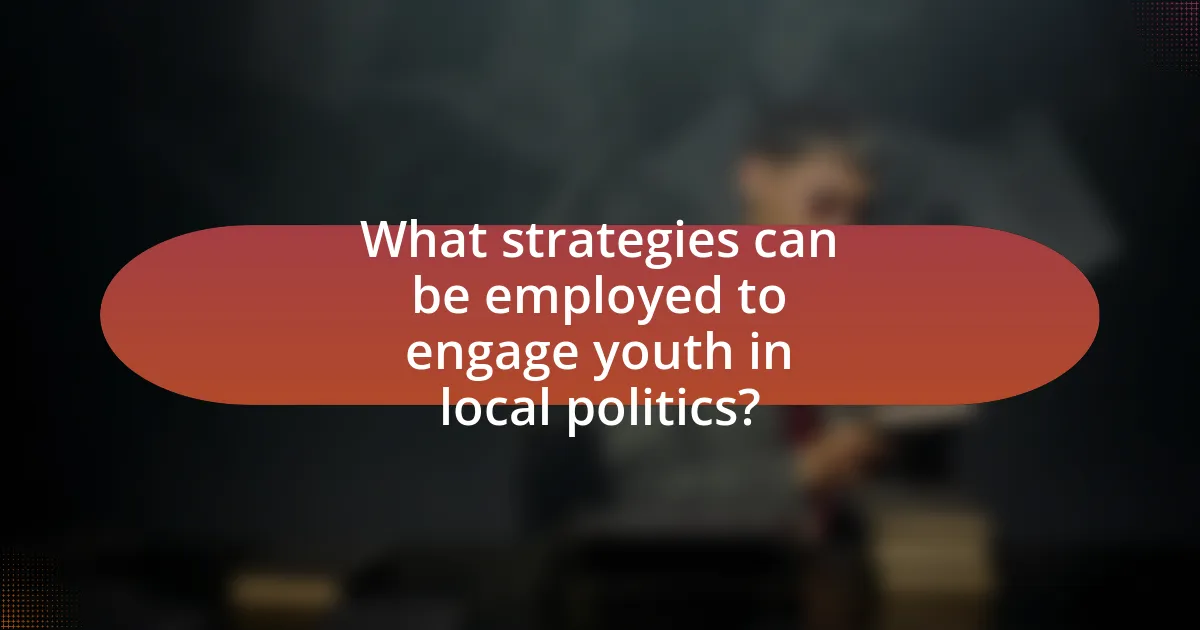
What strategies can be employed to engage youth in local politics?
To engage youth in local politics, strategies such as utilizing social media platforms, organizing community events, and implementing educational programs can be employed. Social media platforms like Instagram and TikTok are effective for reaching younger audiences, as they allow for interactive content that resonates with youth culture. Community events, such as town hall meetings or youth forums, provide a space for young people to voice their opinions and connect with local leaders, fostering a sense of belonging and responsibility. Educational programs in schools that focus on civic engagement and the importance of local governance can empower youth to participate actively in political processes. Research indicates that youth involvement in local politics increases when they feel their voices are heard and valued, highlighting the importance of these strategies in creating an inclusive political environment.
How can local governments effectively reach out to young people?
Local governments can effectively reach out to young people by utilizing social media platforms and engaging in community events. Research indicates that 90% of young people use social media, making it a vital channel for communication and outreach. By creating targeted campaigns on platforms like Instagram and TikTok, local governments can disseminate information about civic engagement opportunities, local issues, and events that resonate with youth interests. Additionally, participating in or sponsoring community events such as music festivals, sports tournaments, or educational workshops allows local governments to interact directly with young people, fostering a sense of community and encouraging their involvement in local politics.
What communication channels are most effective for youth outreach?
Social media platforms are the most effective communication channels for youth outreach. Research indicates that 90% of young people aged 18-29 use social media, making it a crucial tool for engagement. Platforms like Instagram, TikTok, and Snapchat are particularly popular among this demographic, allowing for interactive and visually appealing content that resonates with youth. Additionally, studies show that campaigns utilizing social media can increase participation rates in local politics by up to 30%, highlighting its effectiveness in reaching and mobilizing young audiences.
How can local events be tailored to attract youth participation?
Local events can be tailored to attract youth participation by incorporating elements that resonate with their interests and values, such as music, technology, and social issues. Engaging youth through interactive activities, like workshops or competitions, fosters a sense of ownership and relevance. Additionally, utilizing social media platforms for promotion and feedback ensures that events are visible and appealing to younger demographics. Research indicates that 70% of young people are more likely to participate in events that align with their interests and are promoted through channels they frequently use, such as Instagram and TikTok.
What role do youth organizations play in political engagement?
Youth organizations play a crucial role in political engagement by mobilizing young people to participate in civic activities and advocacy. These organizations provide platforms for education, discussion, and action on political issues that affect youth, fostering a sense of agency and responsibility. For instance, studies show that youth-led initiatives, such as voter registration drives and community forums, significantly increase youth turnout in elections. According to the U.S. Census Bureau, the youth voter turnout in the 2020 election was the highest it had been in decades, partly due to the efforts of organizations like Rock the Vote and the Student Vote Project, which actively engaged young voters.
How can partnerships between organizations enhance youth involvement?
Partnerships between organizations can enhance youth involvement by creating collaborative platforms that provide resources, mentorship, and opportunities for engagement. These partnerships often combine the strengths of various entities, such as non-profits, schools, and local governments, to develop programs that specifically target youth interests and needs. For instance, a study by the National League of Cities found that cities with strong partnerships between local governments and youth organizations reported higher levels of youth participation in civic activities, demonstrating that collaborative efforts can effectively mobilize young people.
What initiatives have proven successful in mobilizing youth voters?
Successful initiatives in mobilizing youth voters include social media campaigns, peer-to-peer outreach programs, and educational workshops. Social media campaigns, such as those run by organizations like Rock the Vote, have effectively reached young audiences, with studies showing that 50% of young voters were influenced by social media in the 2020 election. Peer-to-peer outreach programs, where young volunteers engage their friends and communities, have also proven effective; for instance, the organization Vote.org reported that such initiatives increased voter turnout among young people by 10-15%. Educational workshops that focus on the importance of civic engagement and the voting process have further empowered youth, with research indicating that informed young voters are more likely to participate in elections.
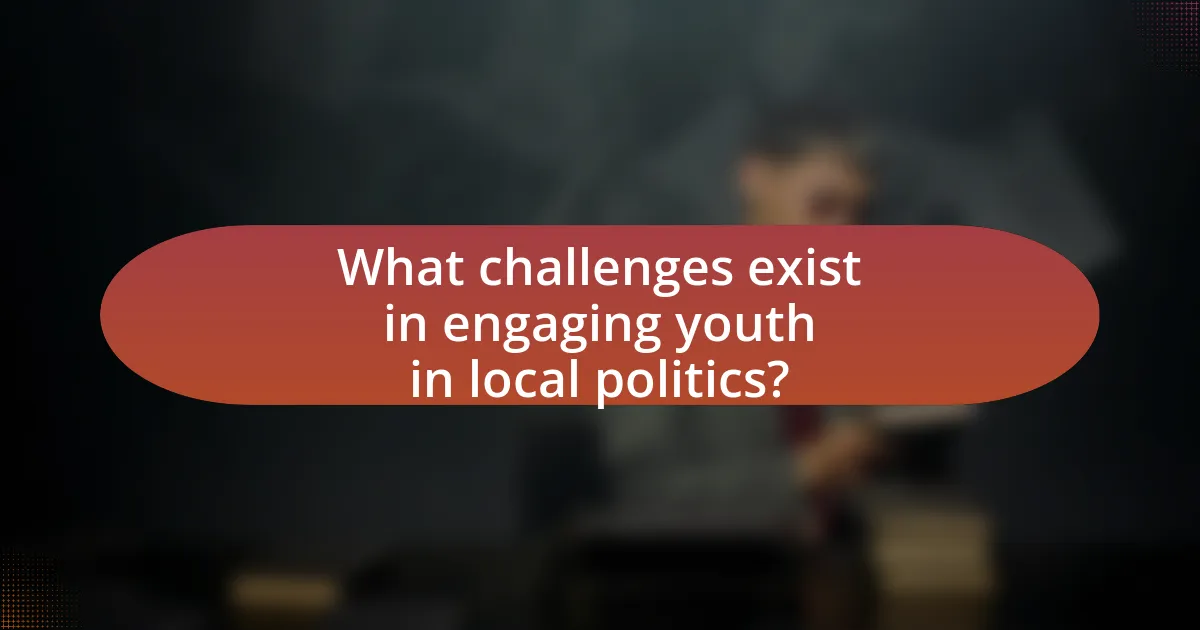
What challenges exist in engaging youth in local politics?
Engaging youth in local politics faces several challenges, including apathy, lack of representation, and limited access to information. Apathy among young people often stems from a belief that their voices do not matter in political processes, which is supported by studies indicating that only 27% of young voters participated in the 2020 U.S. presidential election. Additionally, the underrepresentation of youth in political offices can lead to policies that do not address their specific needs, further discouraging involvement. Limited access to information about local political issues and processes also hinders youth engagement, as many young individuals may not know how to participate effectively or where to find relevant resources.
What barriers prevent youth from participating in local governance?
Barriers preventing youth from participating in local governance include lack of awareness, limited access to information, and perceived irrelevance of political processes. Many young individuals are unaware of local governance structures and their roles, which diminishes their motivation to engage. Additionally, insufficient access to information about local issues and governance can hinder informed participation. Research indicates that youth often perceive political processes as irrelevant to their lives, leading to disengagement. For instance, a study by the International Institute for Democracy and Electoral Assistance found that 60% of young people feel their voices are not heard in political discussions, reinforcing the notion that local governance does not address their concerns.
How do socioeconomic factors influence youth political engagement?
Socioeconomic factors significantly influence youth political engagement by shaping access to resources, education, and social networks. Youth from higher socioeconomic backgrounds often have greater access to educational opportunities and civic resources, which can enhance their political knowledge and participation. For instance, a study by the Pew Research Center found that young individuals with higher family incomes are more likely to vote and engage in political discussions compared to their lower-income peers. Additionally, socioeconomic status affects the availability of time and energy for political activities; youth from economically disadvantaged backgrounds may prioritize immediate survival needs over political involvement. This disparity in engagement is further evidenced by research from the Center for Information & Research on Civic Learning and Engagement, which indicates that socioeconomic status correlates with levels of civic engagement among young people.
What misconceptions exist about youth involvement in politics?
One misconception about youth involvement in politics is that young people are apathetic and uninterested in political issues. In reality, research shows that youth engagement has been increasing, with 50% of eligible voters aged 18-29 participating in the 2020 U.S. presidential election, a significant rise from previous years. Another misconception is that young individuals lack the knowledge or experience to contribute meaningfully to political discussions; however, many young activists are well-informed and actively advocate for issues such as climate change and social justice. These misconceptions overlook the active role that youth play in shaping political discourse and their capacity to influence change.
How can these challenges be addressed effectively?
To address the challenges of engaging youth in local politics effectively, local governments and organizations should implement targeted outreach programs that resonate with young people’s interests and values. Research indicates that initiatives such as social media campaigns, interactive workshops, and mentorship programs can significantly increase youth participation in political processes. For instance, a study by the National League of Cities found that cities employing social media strategies saw a 30% increase in youth engagement in local governance activities. By utilizing platforms that young people already frequent, local entities can foster a sense of community and relevance, ultimately encouraging more active involvement in political discussions and decision-making.
What strategies can be implemented to overcome barriers to engagement?
To overcome barriers to engagement, strategies such as fostering inclusive environments, utilizing technology, and providing education on civic responsibilities can be implemented. Creating inclusive environments encourages participation by ensuring that all voices are heard and valued, which is essential for youth engagement. Utilizing technology, such as social media platforms, allows for broader outreach and facilitates communication, making it easier for young people to connect with local political initiatives. Additionally, providing education on civic responsibilities equips youth with the knowledge and skills necessary to engage effectively in local politics. Research indicates that when young people feel informed and included, their likelihood of participating in political processes increases significantly.
How can mentorship programs support youth in politics?
Mentorship programs can support youth in politics by providing guidance, resources, and networking opportunities that enhance their political engagement and skills. These programs connect young individuals with experienced political leaders who can share insights on navigating political systems, understanding policy-making processes, and developing leadership qualities. Research indicates that mentorship can significantly increase youth participation in civic activities; for instance, a study by the National Mentoring Partnership found that mentored youth are 55% more likely to enroll in college and 78% more likely to volunteer regularly in their communities. This evidence underscores the effectiveness of mentorship in fostering a new generation of politically active individuals.
What best practices can enhance youth engagement in local politics?
Best practices that can enhance youth engagement in local politics include creating accessible platforms for participation, fostering mentorship programs, and integrating civic education into school curricula. Accessible platforms, such as online forums and social media campaigns, allow youth to express their opinions and engage with local issues effectively. Mentorship programs connect young individuals with experienced political figures, providing guidance and encouragement to participate in political processes. Additionally, integrating civic education into school curricula equips students with the knowledge and skills necessary to understand and engage in local governance. Research indicates that youth who receive civic education are more likely to vote and participate in community activities, demonstrating the effectiveness of these practices in fostering engagement.
